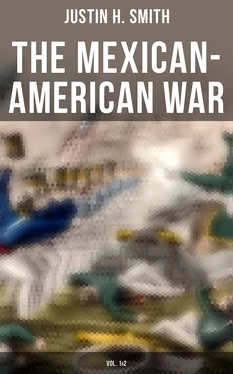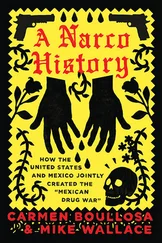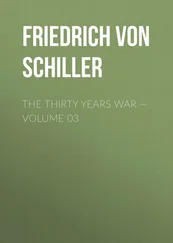Justin H. Smith
The Mexican-American War (Vol. 1&2)
Historical Account of the Conflict Between USA and Mexico in 1846-1848
Published by
 Books
Books
Advanced Digital Solutions & High-Quality eBook Formatting
musaicumbooks@okpublishing.info2018 OK Publishing ISBN 978-80-272-4043-2
VOLUME I VOLUME I Table of Contents
Preface
Conspectus of Events
Pronunciation of Spanish
I. Mexico and the Mexicans
II. The Political Education of Mexico
III. The Relations between the United States and Mexico, 1825–1843
IV. The Relations between the United States and Mexico, 1843–1846
V. The Mexican Attitude on the Eve of War
VI. The American Attitude on the Eve of War
VII. The Preliminaries of the Conflict
VIII. Palo Alto and Resaca de Guerrero
IX. The United States Meets the Crisis
X. The Chosen Leaders Advance
XI. Taylor Sets out for Saltillo
XII. Monterey
XIII. Saltillo, Parras, and Tampico
XIV. Santa Fe
XV. Chihuahua
XVI. The California Question
XVII. The Conquest of California
XVIII. The Genesis of Two Campaigns
XIX. Santa Anna Prepares to Strike
XX. Buena Vista
Notes on Volume I
Appendix (Manuscript Sources)
VOLUME II
XXI. Behind the Scenes at Mexico
XXII. Vera Cruz
XXIII. Cerro Gordo
XXIV. Puebla
XXV. On to the Capital
XXVI. Contreras and Churubusco
XXVII. Negotiations
XXVIII. Molino del Rey, Chapultepec and Mexico
XXIX. Final Military Operations
XXX. The Naval Operations
XXXI. The Americans as Conquerors
XXXII. Peace
XXXIII. The Finances of the War
XXXIV. The War in American Politics
XXXV. The Foreign Relations of the War
XXXVI. Conclusion
Notes on Volume II
Appendix (Manuscript Sources)
Table of Contents
Table of Contents
As every one understands, our conflict with Mexico has been almost entirely eclipsed by the greater wars following it. But in the field of thought mere size does not count for much; and while the number of troops and the lists of casualties give the present subject little comparative importance, it has ample grounds for claiming attention. As a territorial stake New Mexico, Arizona and California were of immense value. National honor was involved, and not a few of the Mexicans thought their national existence imperilled. Some of the diplomatic questions were of the utmost difficulty and interest. The clash of North and South, American and Mexican, produced extraordinary lights and shades, and in both countries the politics that lay behind the military operations made a dramatic and continual by-play. The military conduct of the governments—especially our own—and the behavior of our troops on foreign soil afforded instruction worthy to be pondered. While vast concentrations of forces and complicated tactical operations on a great scale were out of the question, the handling of even small armies at a long distance from home and in a region that was not only foreign but strange, created problems of a peculiar interest and afforded lessons of a peculiar value, such as no earlier or later war of ours has provided; and the examples of courage, honor and heroism exhibited in a conflict not only against man but against nature merited correct appreciation and lasting remembrance. 1 A
The warrant for offering another work on the subject rests primarily on the extent and results of the author’s investigations. His intention was to obtain substantially all the valuable information regarding it that is in existence, and no effort was spared to reach his end. The appendix of volume II gives a detailed account of the sources. By special authorization from the Presidents of the United States and Mexico it was possible to examine every pertinent document belonging to the two governments. The search extended to the archives of Great Britain, France, Spain, Cuba, Colombia and Peru, those of the American and Mexican states, and those of Mexican cities. The principal libraries here, in Mexico and in Europe, the collections of our historical societies, and papers belonging to many individuals in this country and elsewhere were sifted. It may safely be estimated that the author examined personally more than 100,000 manuscripts bearing upon the subject, more than 1200 books and pamphlets, and also more than 200 periodicals, the most important of which were studied, issue by issue, for the entire period.B Almost exclusively the book is based upon first-hand sources, printed matter having been found of little use except for the original material it contains or for data regarding biography, geography, customs, industries and other ancillary subjects.2
The author also talked or corresponded with as many of the veterans as he could reach, and he spent more than a year, all told, in Mexico, where he not only studied the chief battlefields but endeavored, through conversations with Mexicans of all grades and by the aid of foreigners long resident in the country, to become well acquainted with the character and psychology of the people. As the war was fought almost exclusively among them, and its inception, course and results depended in large part upon these factors, the author attaches not a little importance to his opportunities for such personal investigations and to his Mexican data in general.2
Probably more than nine tenths of the material used in the preparation of this work is in fact new. No previous writer on the subject had been through the diplomatic and military archives of either belligerent nation, for example. Virtually a still larger percentage is new, for the published documents needed to be compared with the originals. In the printed American reports relating to the battles of September 8 and 13, 1847, for instance, over fifty departures from the manuscripts, that seemed worth noting, were found. Nor did the additional documents prove by any means to supply mere details. A great number of unprinted statements from subordinate officers, who were nearer to the facts than their superiors could be, were discovered. The major official reports needed both to be supplemented and to be corrected. Such reports were in most instances colored more or less, and in some radically distorted, for personal reasons or from a justifiable desire to produce an effect on the subordinates concerned, the army in general, the writer’s government, the enemy, and the public at home and abroad; while, as General Scott stated in orders, unintentional omissions and mistakes were “common.” Taylor’s account of the battle of May 9, 1846, for example, failed completely to explain his victory. It has been only by obtaining and comparing a large number of statements that approximate verity has been reached. The same has been true of the diplomatic and political aspects of the subject. The reports of the British, French and Spanish ministers residing at Mexico, to cite one illustration, proved indispensable. In reality, therefore, aside from its broader outlines the field presented ample opportunities for study; and while no doubt so extended an investigation included many facts of slight value, La Rochefoucauld was right when he said, “To know things perfectly, one should know them in detail.”3
As a particular consequence of this full inquiry, an episode that has been regarded both in the United States and abroad as discreditable to us, appears now to wear quite a different complexion. Such a result, it may be presumed, will gratify patriotic Americans, but the author must candidly admit that he began with no purpose or even thought of reaching it. His view of the war at the outset of his special inquiries coincided substantially with that prevailing in New England, and the subject was taken up simply because he felt convinced that it had not been studied thoroughly. This conviction, indeed, has seemed to be gaining ground rapidly for some time, and hence it is believed that new opinions, resting upon facts, will be acceptable now in place of opinions resting largely upon traditional prejudices and misinformation.
Читать дальше

 Books
Books










